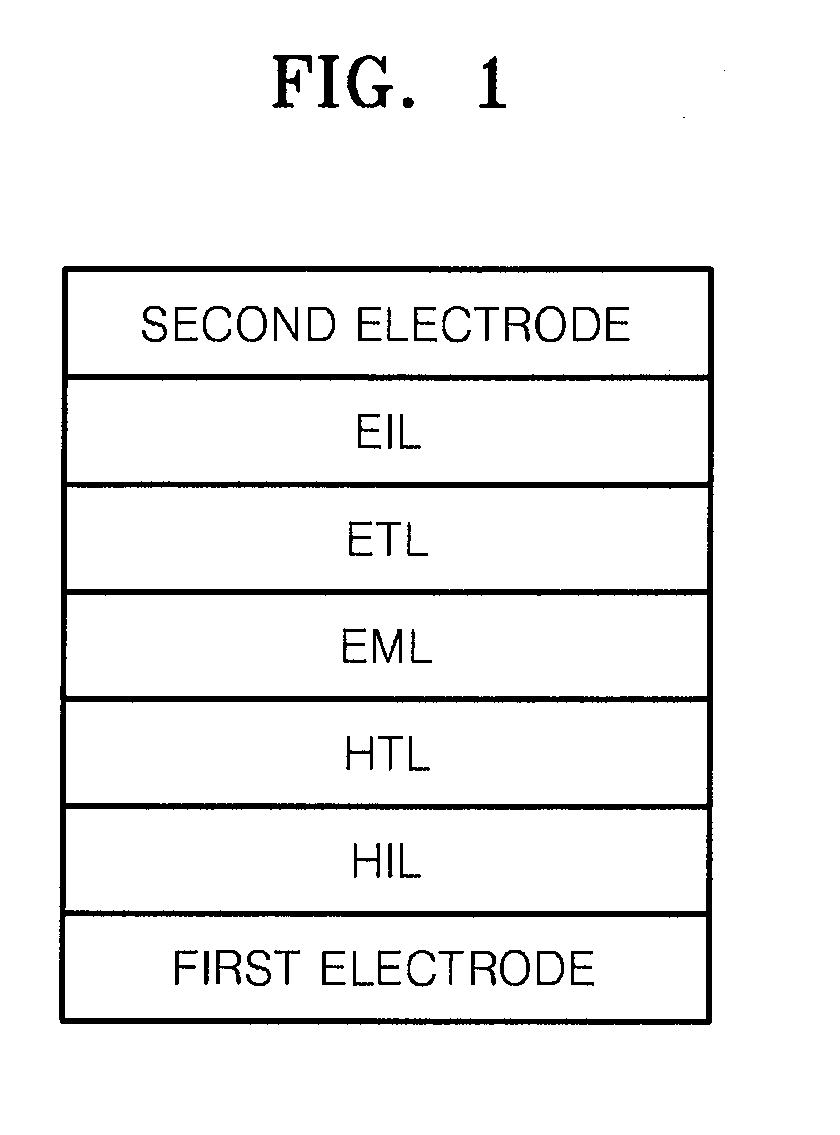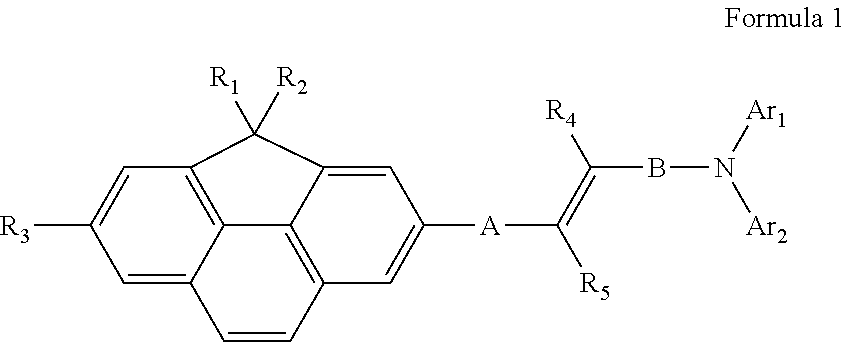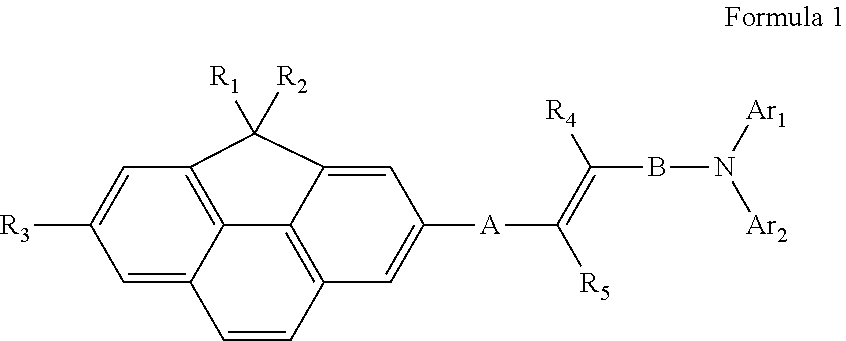Compound for organic light-emitting device and organic light-emitting device including the same
a light-emitting device and organic technology, applied in the direction of luminescent compositions, thermoelectric devices, organic chemistry, etc., can solve the problems of material efficiency, driving voltage, lifetime, etc., and achieve the effects of improving electrical characteristics, low voltage, and improving efficiency
- Summary
- Abstract
- Description
- Claims
- Application Information
AI Technical Summary
Benefits of technology
Problems solved by technology
Method used
Image
Examples
synthesis example 1
Synthesis of Intermediate I-1 (Synthetic Pathway 1)
[0132]
Synthesis of Intermediate I-1
[0133]2.971 g (10 mmol) of 2-bromo-4,4-dimethyl-cyclopentaphenanthrene, 2.200 g (11 mmol) of 4-bromophenyl boronic acid, 0.577 g (0.5 mmol) of tetrakis(triphenylphosphine)palladium (Pd(PPh3)4), and 1.658 g (12 mmol) of K2CO3 were dissolved in 100 mL of a mixed solution of tetrahydrofuran (THF) and H2O (2:1 by volume) to obtain a solution, which was then stirred at about 80° C. for about 5 hours. The reaction solution was cooled to room temperature, and 40 mL of water was added thereto, followed by extraction three times with 50 mL of ethyl ether. The organic phase was collected and dried using magnesium sulfate, and the solvent was evaporated. The residue was separated using silica gel column chromatography to obtain 2.132 g (5.73 mmol) of Intermediate I-1 (Yield: 57.3%). This compound was identified using mass spectroscopy / fast atom bombardment (MS / FAB). [calc.: 372.05, found: 373.22].
synthesis example 2
Synthesis of Intermediate I-4 (Synthetic Pathway 2)
[0134]
Synthesis of Intermediate I-2
[0135]3.566 g (30 mmol) of o-toluenamine, 3.420 g (20 mmol) of 2-bromotoluene, 0.915 g (0.1 mmol) of tris(dibenzylideneacetone)dipalladium) (Pd2(dba)3), 0.202 g (0.1 mmol) of PtBu3, and 2.883 g (30 mmol) of KOtBu were dissolved in 100 mL of toluene to obtain a solution, which was then stirred at about 85° C. for about 4 hours. The reaction solution was cooled to room temperature, followed by extraction three times with 100 mL of water and 100 mL of diethyl ether. The organic phase was collected and dried using magnesium sulfate, and the solvent was evaporated. The residue was separated using silica gel column chromatography to obtain 3.349 g (17 mmol) of Intermediate I-2 (Yield: 79%). This compound was identified using MS / FAB. [calc.: 197.28, found: 198.10].
Synthesis of Intermediate I-3
[0136]4.812 g (12 mmol) of Intermediate I-3 was synthesized using 3.349 g (17 mmol) of Intermediate I-2 and 7.291 ...
synthesis example 3
Synthesis of Intermediate I-5 (Synthetic Pathway 3)
[0138]
[0139]0.744 g (2 mmol) of Intermediate I-1, 0.700 g (2 mmol) of Intermediate I-4, 0.022 g (0.1 mmol) of Pd(OAc)2, 0.030 g (0.1 mmol) of tri(o-tolyl)phosphine ((p-tolyl)3P), and 0.202 g (2 mmol) of triethylamine (Et3N) were dissolved in 10 mL of dimethylacetamide (DMAc) to obtain a solution, which was then stirred at about 85° C. for about 4 hours. The reaction solution was cooled to room temperature, followed by extraction three times with 30 mL of water and 30 mL of diethyl ether. The organic phase was collected and dried using magnesium sulfate and the solvent was evaporated. The residue was separated using silica gel column chromatography to obtain 1.284 g (1.2 mmol) of Intermediate I-5 (Yield: 60%). This compound was identified using MS / FAB. [calc.: 641.31, found: 642.20].
PUM
| Property | Measurement | Unit |
|---|---|---|
| pressure | aaaaa | aaaaa |
| temperature | aaaaa | aaaaa |
| temperature | aaaaa | aaaaa |
Abstract
Description
Claims
Application Information
 Login to View More
Login to View More - R&D
- Intellectual Property
- Life Sciences
- Materials
- Tech Scout
- Unparalleled Data Quality
- Higher Quality Content
- 60% Fewer Hallucinations
Browse by: Latest US Patents, China's latest patents, Technical Efficacy Thesaurus, Application Domain, Technology Topic, Popular Technical Reports.
© 2025 PatSnap. All rights reserved.Legal|Privacy policy|Modern Slavery Act Transparency Statement|Sitemap|About US| Contact US: help@patsnap.com



